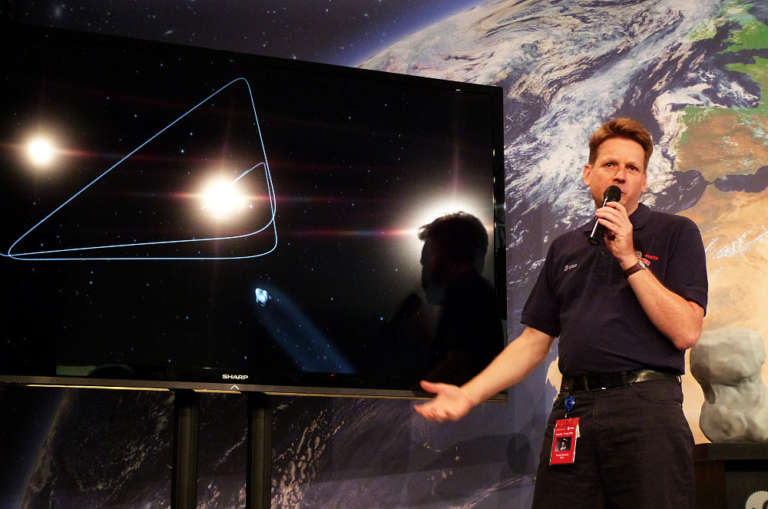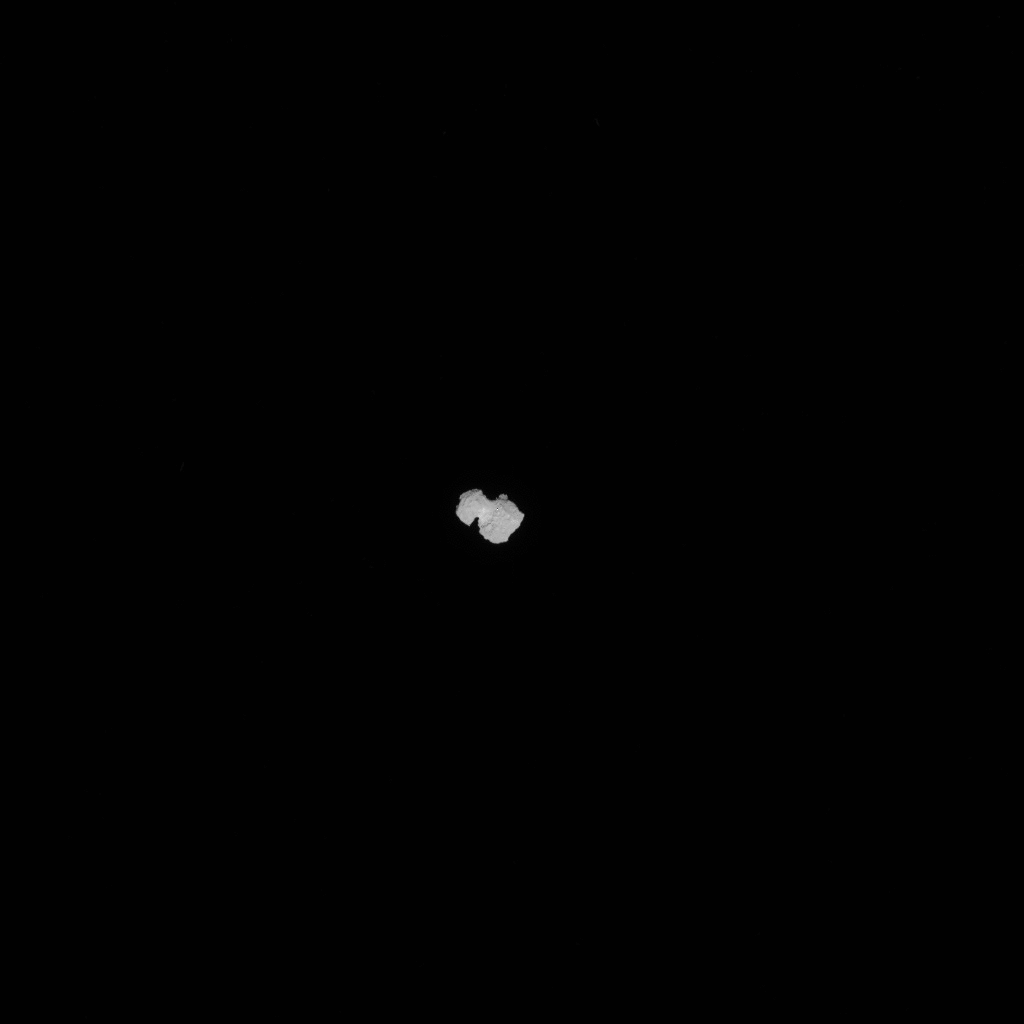Daniel Fischer • Aug 06, 2014
Rendezvous with a crazy world
Beaming scientists all around, spectacular images on large TV screens, and the best - or at least most exciting - yet to come: such was the extraordinary scene at the European Space Operations Centre in Darmstadt, Germany, today as the European Space Agency's Rosetta spacecraft reached its cometary destination after a ten-year journey and some three decades after the project was first hatched.

The key moment came in the afternoon when Holger Sierks, the principal investigator of Rosetta's camera OSIRIS, stormed the stage of the new ESOC press center. He was carrying a laptop: on its screen the very latest and most detailled - by some margin! - images of the nucleus of comet Churyumov-Gerasimenko, obtained in the early morning at a distance of 120 km and just downlinked from Rosetta and processed. They blew out of the water even the images from 285 km he had shared this morning. The utterly bizarre shape of this nucleus - if still to be compared with a rubber duck, then it's one after a bad car crash - was well-known by then. In the new images was what had been waiting for Rosetta on the surface: a bewilderingly complex landscape with apparent landslides, boulders and valleys.

(Visit Emily Lakdawalla's blog entry for a gallery of all the images released on the day of arrival.)
No comet nucleus had ever been seen with such clarity, with a resolution of just two to three meters per pixel. Even if Rosetta fell silent forever, some people opined, cometary science had already been revolutionized (though few would dare to make a public guess about what all the complex details actually meant). Yet, the Rosetta mission has hardly begun: no in-situ experiment aboard the spacecraft has yet seen a clear-cut signature of the comet, because it is still rather inactive, far from the Sun. In particular the Philae lander won't be released to the surface for another three months. It's all remote sensing for the time being.

Glimpses of two more such early datasets were also provided on arrival day. One came from the VIRTIS infrared instrument that saw the nucleus temperature vary with its 12-hour rotation, the other one was from the little radio telescope MIRO. It had seen water production, i.e. the release of H2O molecules, slowly ramp up, and also witnessed a strong vatiation with two peaks per complete rotation.

MIRO's PI Samuel Gulkis - who is from the Jet Propulsion Laboratory; Rosetta has a U.S. component, too - showed me his unpublished data: while water production is only on the order of 10^25 molecules per second now, the radio emmission is clear and shows all kinds of interesting variations over longer time as well. Interestingly, the very latest data points reveal a significant drop of the signal, apparently a signature of the coma - though it looks feeble in visible light - already becoming optically thick for radio waves. MIRO thus cannot see all the radiating molecules anymore while in reality there are more than ever. As most other instruments MIRO is currently used both as a science and an engineering tool: in the coming three months, the properties of C-G's nucleus such as its exact shape and mass distribution and its behavior over time - how fast is activity increasing? - need to be understood in as much detail as possible before the Philae lander can be dropped for a dramatically closer investigation of the comet.
The decidedly non-round shape of the nucleus - in stark contrast to confident predictions of a rather spherical body based on the latest pre-arrival astronomical observations - isn't making things easier for landing, although quite a number of technically suitable landing zones have already now been pinpointed even at this early stage. A firm recommendation of the landing spot is expected in mid-September (with the announcement probably in another major media event, tentatively scheduled for September 25) and a firm decision by October.
But this is still far in the future: Rosetta isn't even in an orbit around the comet yet! From the perspective of the nucleus, the spacecraft has slowed down to human walking speed, but it is still on a hyperbolic escape trajectory because the comet's gravity is so slight. Further gentle engine burns will periodically kick Rosetta back towards the comet, so that Rosetta flies along two triangles in the proximity of the comet, the current one about 100 kilometers away, the next one at 50 kilometers. Only when the distance has been further reduced to about 30 kilometers will Rosetta feel the comet's feeble gravity enough to enter an orbit for good.

And here is one particularly good piece of news for Rosetta's fans: the nearly continuous stream of nucleus images by Rosetta's navigation camera will continue, and everything will be put on a web server shortly, for image processing aficionados to try their luck on them. Already today a brief approach video from NavCam imagery was shown, with the comet disappearing from the field of view at the end. The reason was a small error in one of the trajectory correction burns that was swiftly corrected in the next one.

The Rosetta project had been going on for so long that many of the scientists and managers who saw it from initiation to launch have long since retired, but quite a few of them had now reconvened at ESOC for the momentuous occasion. Among them was David Southwood, who was ESA's science director in the turbulent months of 2003 and 2004 when Rosetta had suddenly lost its original target, comet Wirtanen, because of rocket problems, and astronomers were scrambling to find a replacement. (One has to wonder now whether Wirtanen would have been as exciting a cosmic body as the once-unloved consolation prize C-G). Southwood told me he had seen so many missions sent off into space that he couldn't even count them, but Rosetta has caused by far the most complications of them all. And now he could simply relax and enjoy the huge success. Incidentally, Rosetta itself had been a consolation prize, too, for a cancelled joint NASA-ESA comet nucleus sample return mission. Could the space agencies have pulled off this even bigger feat with 1980s technology? Southwood thinks so - for an equivalent of 3 billion Euros perhaps. But just getting some comet sample back from a random location, he argues, wouldn't make nearly as much sense as the thorough investigation of Churyumov-Gerasimenko that has begun today. A new chapter in comet science has begun for good.

The Time is Now.
As a Planetary Defender, you’re part of our mission to decrease the risk of Earth being hit by an asteroid or comet.
Donate Today

 Explore Worlds
Explore Worlds Find Life
Find Life Defend Earth
Defend Earth

